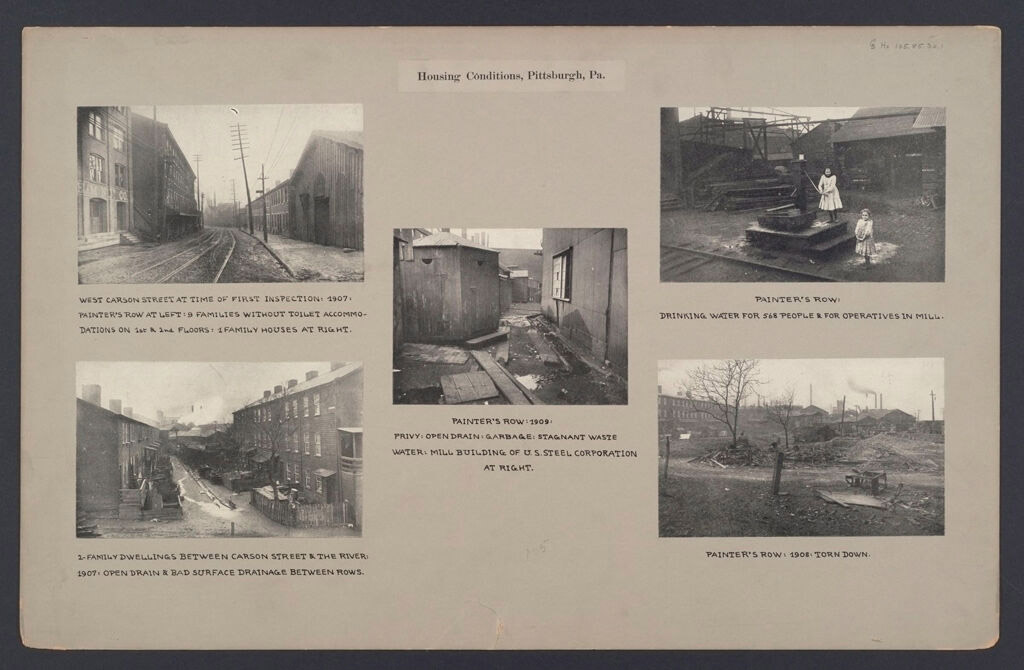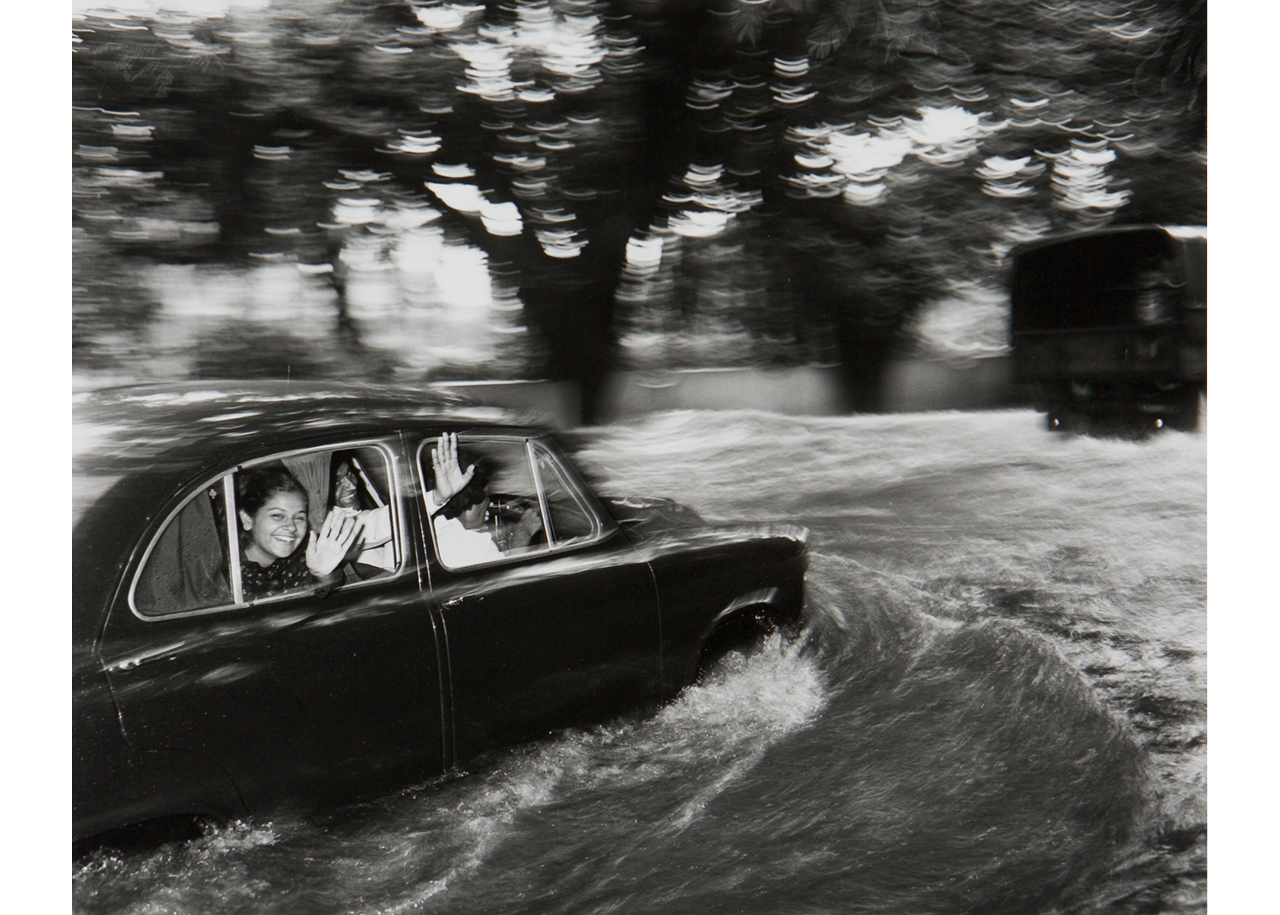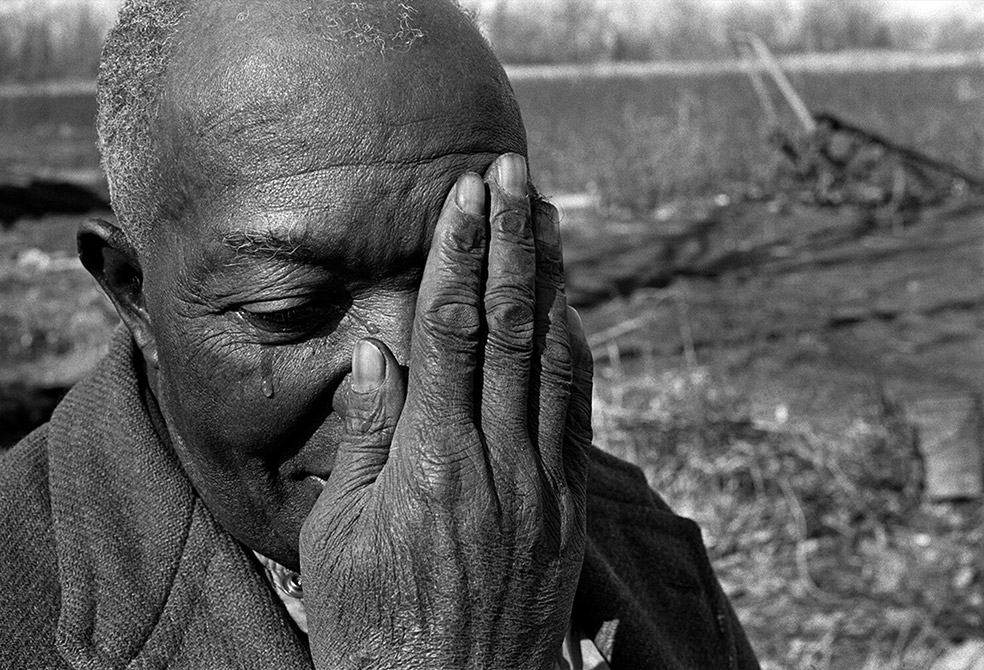CODA
Whether in the Global South or North, the impact of climate change is greater in economically disadvantaged communities. In the Pittsburgh Survey, 1907-1908, sociological photographer Lewis Hine captured destitute living conditions of poor neighborhoods in Pittsburgh. From open drains to insufficient water supply, the attention to the inadequate water management system helped argue for political reforms as seen in this public presentation board. Extreme weather events can hit everyone everywhere. Driving through flooded streets of Mumbai captured by Belgian photographer Carl de Keyzer seems precarious if not near impossible. Passengers look jolly while the driver looks extremely tense. Devastation of the aftermath of flood is viscerally portrayed in a powerful photograph by American photographer Eugene Richards. The only water visible in the frame is a drop of tear rolling down the man’s cheek, yet we can feel the weight of the mighty rain that brought destruction to his farmland. [JK]
Lewis W. Hine (?)

Housing Conditions: United States. Pennsylvannia. Pittsburgh.
Houses; Streets; Yards: Housing Condtions, Pittsburgh. Pa.
Lewis W. Hine (? 1874-1940, American)
1907-1909
Photographic prints on a mounting board
Harvard Art Museums/Fogg Museum, Transfer from the Carpenter Center for the Visual Arts, Social Museum Collection, 3.2002.39
Famous for his portrayal of child laborers and advocacy for ending child labor in the US, Lewis Hine started his career as a educational photographer documenting immigrants at Ellis Island beginning in 1904. In 1907, he was asked to be a photographer for the Pittsburgh Survey (1907-8), a groundbreaking social survey project that documented living conditions of the urban poor. Five monochrome prints of photographs most likely taken by Lewis Hine during his time as the staff photographer for the project are mounted on a display board. They report on deprived living conditions in the area known as Painter’s Row where the United States Steel Corporation housed workers who were mostly immigrants. As explained in the accompanying text, the destitute conditions are marked by highlighting the dismal water management system such as open drain, lack of bathrooms in living quarters, and limited access to water. The display board was probably put together and displayed at the Social Museum of Harvard University founded by Francis Greenwood Peabody (1847-1936) in 1903 and opened its doors to the public in 1907 “to promote investigations of modern social conditions and to direct the amelioration of industrial and social life”. [JK] 1
1 Francis G. Peabody, The Social Museum as an Instrument of University Teaching. Publications of the Department of Social Ethics in Harvard University, no. 4 (Cambridge, MA: Harvard University, 1911), 2.
Carl de Keyzer

Bombay, India
Carl de Keyzer (Belgian, 1958)
1985
Gelatin Silver Print
Harvard Art Museums/Fogg Museum, Transfer from the Fine Arts Library, Harvard University, Photo President and Fellows of Harvard College, P1998.42
Flash flooding is a common phenomenon in coastal cities of India. Belgian photographer Carl de Keyzer captured a passing moment on the flooded streets of Mumbai during the monsoon season. A shiny car, probably a black Hindustan Ambassador, wades through a huge body of water - the flood water seems nearly 3 feet deep. The passengers looking at the photographer appear jolly with palpable excitement of being documented in the midst of an almost quixotic journey driving through what looks like a swirling river after a torrential storm while the driver in charge of the task appears tense at wheel. While photographs of cars navigating water-filled streets may be associated with climate disasters, the monsoon that probably caused this flood usually brings a welcome respite from relentless heat and drought and is much celebrated in South Asia, although such joyful mood of monsoon may become a thing of the past given the impact of climate change on the monsoon patterns that cause extreme weather events like 2022 Pakistani flood. [JK]
Eugene Richards

Farm Taken by Flood Waters, West Memphis, Arkansas
Eugene Richards (b. 1944- American)
1971
Gelatin Silver Print
HarvardArt Museums/Fogg Museum, Purchase through the generosity of Melvin R. Seiden, ©Eugene Richards, Photo President and Fellows of Harvard College, P1982.141
American photographer Eugene Richards joined VISTA, Volunteers in Service to America, in 1968 and spent four years in the southeastern part of Arkansas, helping the poor communities of the region. He used his photographic skills to document the lives of people, especially of the black community. His candid photographs capture moments of both anguish and joy, including scenes from home, fields, church, and even prison, which were published in his first photo essay volume Few Comforts or Surprises: The Arkansas Delta (1973). The close up portrait of a man in despair against a barren field belongs to this series of photographs that Eugene Richards took during his sojourn in West Memphis, Arkansas. The dramatic contrast in tonality that accentuates every wrinkle and gray hair along with smooth finish of the gelatin silver print convey the sorrow of the man viscerally in this black and white photograph. The only water visible in the frame is a drop of tear rolling down the man’s cheek, yet we can feel the weight of the mighty rain that brought destruction to his farmland. [JK]